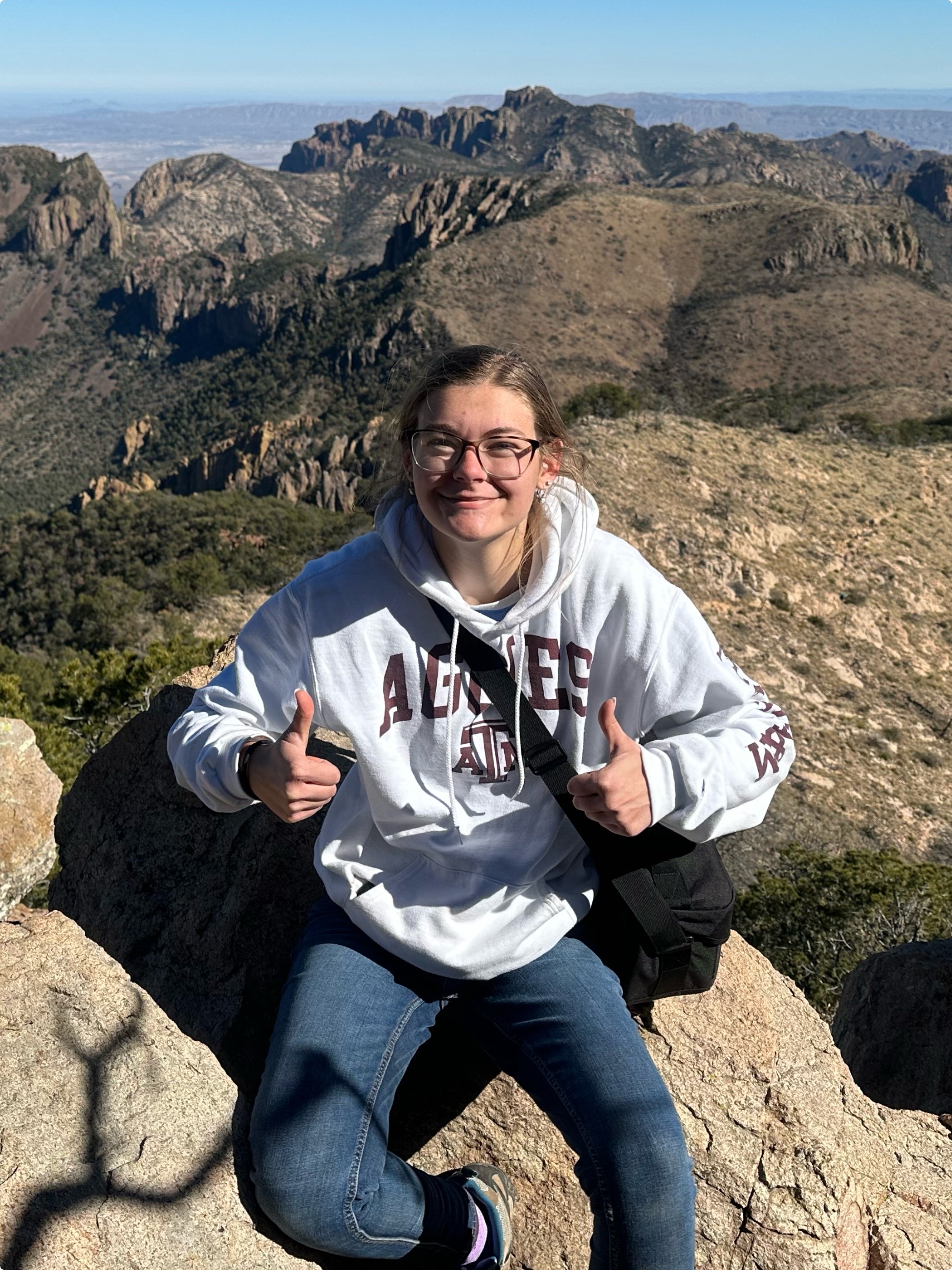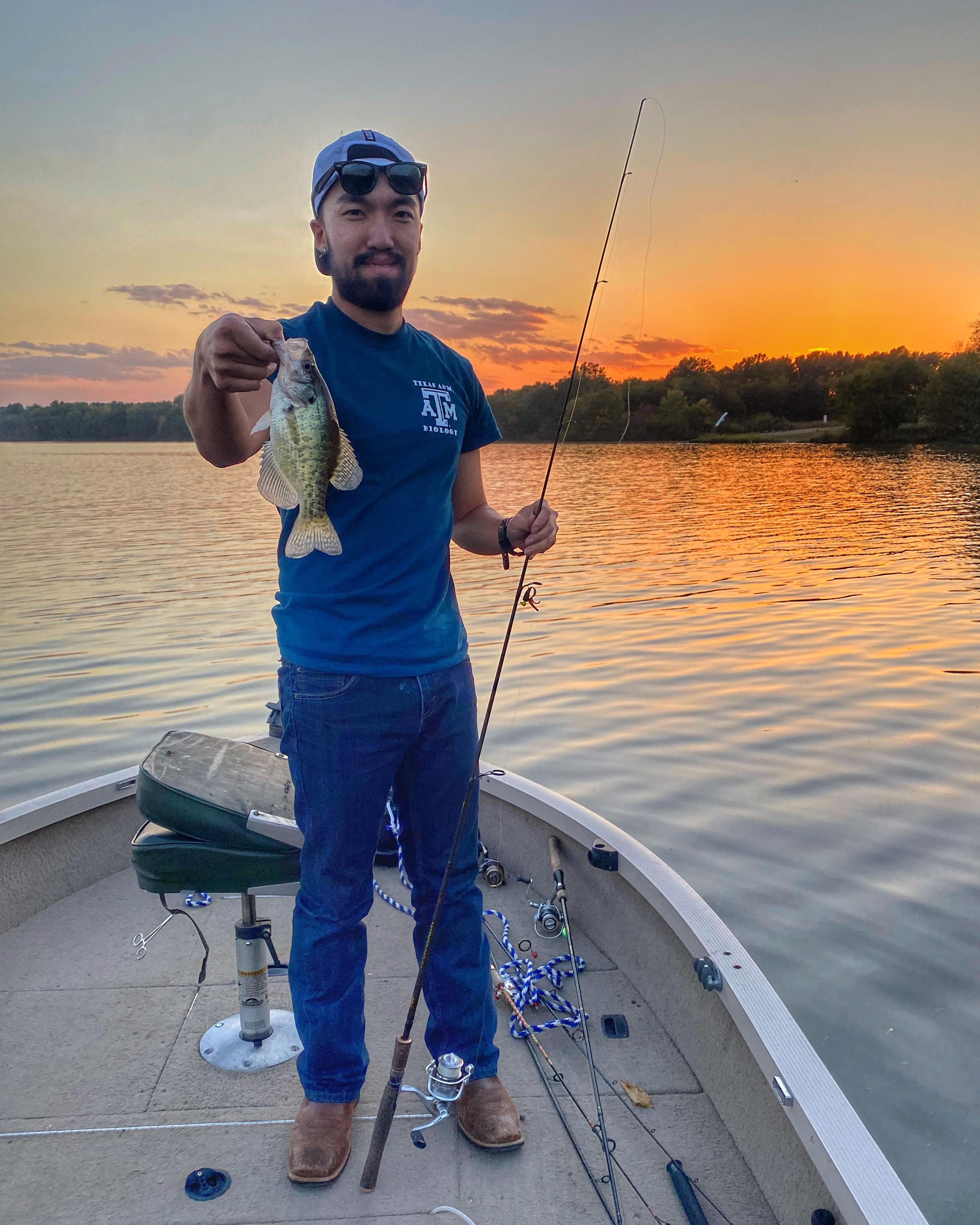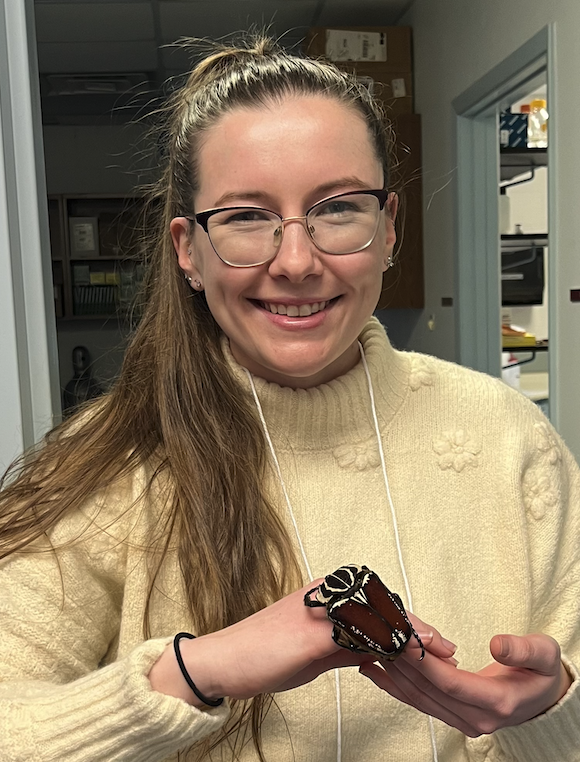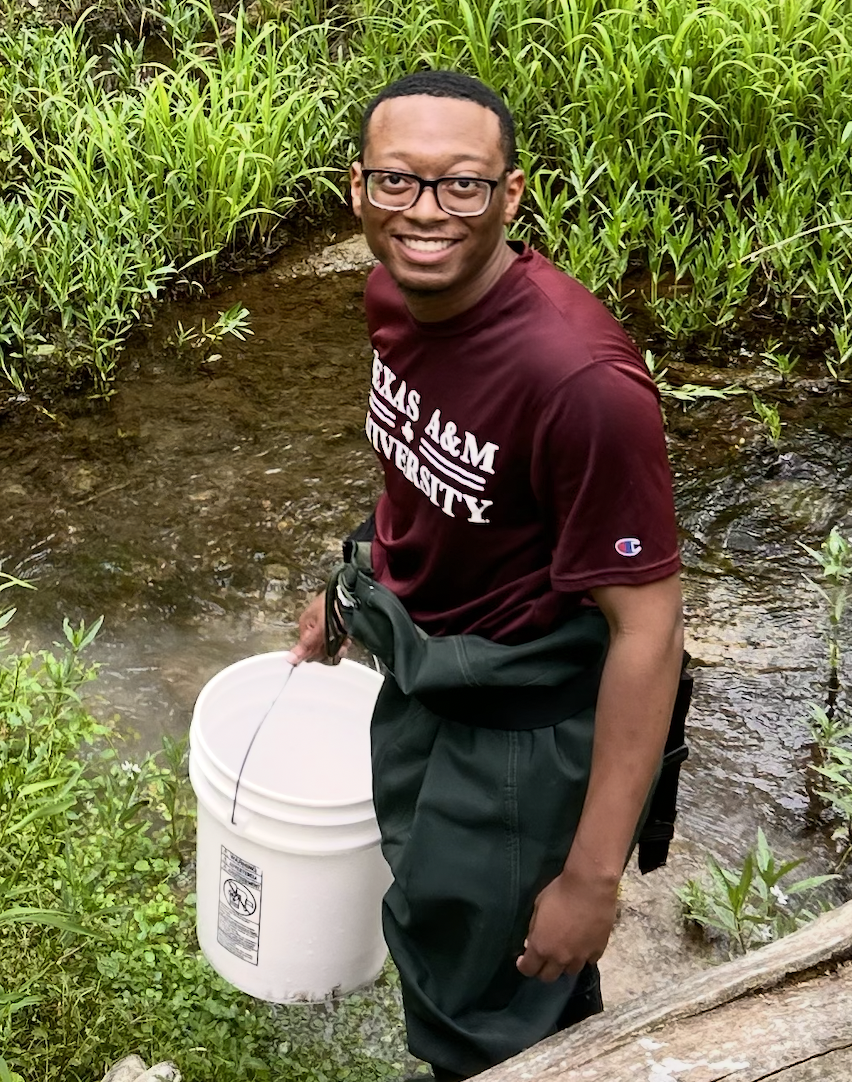
Evolutionary Biology
Research

The Blackmon Lab is in the Biology Department at Texas A&M University. Our ultimate goal is to understand how and why the structure of genomes evolves the way it does across the tree of life. To understand genome structure, we study a broad range of organisms, including tomatoes, betta fish, beetles, chickens, and mammals. Genome structure is a broad term, but so are the aspects of genome structure that we investigate (e.g., chromosome number, sex chromosomes, structural mutations). We also have projects that focus on forces that impact genome structure (e.g., epistasis and sexual antagonism).
We use three approaches to investigate each question we face in our research. First, we use theoretical population genetics to ask "what can happen?" Next, we use comparative methods and leverage data from 10s to 100s of species to ask, "what has happened over many millions of years?" Finally, we use genetics and genomics with emerging model organisms to ask, "what is happening from one generation to the next?"
Questions our lab is currently focused on:
1) What evolutionary forces lead to the divergence of sex chromosomes, and what forces act on "old" highly diverged sex chromosomes?
2) Why does chromosome number evolve rapidly in some clades but remains nearly static in others?
3) Is there an ideal chromosome number, and if so, what determines that value?
4) What determines the fate of mutations that expand the proportion of the genome linked to a sex-determining locus?
5) Are there inherent fitness trade-offs between male and female phenotypes, or can a single genome be fit regardless of sex?
6) Does the importance of epistasis vary across plants and animals?
7) How does domestication impact organisms? What can we learn about adaptation and radiation from studying domestication?
Blackmon Lab AI Generated Research Podcasts:
I have been playing with Google's notebook lm studio tool. It allows you to provide their model with a collection our sources and then generates a podcast based on those documents. The podcasts below are ones I generated based on papers from the lab. Note this tool has some consistant and odd mispronunciations that I have yet to solve.
Sex Chromosomes:
Quantitative Genetics and Epistasis:
Chromosome Number:
Resources
We devote a fair amount of our efforts to producing new datasets, software, and resources for both research and teaching. If you have any questions about these projects please dont hesitate to contact us for additional information.
Lab Meetings
Lab meetings are mandatory for all lab members and occur on Fridays at 10:00 AM in BSBW 425. If we are discussing a paper all students are expected to come to lab meetings with either questions or comments.
meet with Dr. Blackmon on zoom
Teaching
Phylogenetics 101: This page has materials for a 3 hour introduction to phylogenetics. This is targeted at a level that is appropriate for students that have little to no experience with actually inferring phylogenies. Peraphs upper level undergraduates or early graduate students in non phylogenetics labs.
Fall 2025 Journal Club: This semester's journal club will focus on reading articles from each of the 2024 issues of the Journal of Evolutionary Biology.
Experimental Design Course: This course is intended to provide a foundation in the proper design of scientific research projects in the field of biology. A wide range of biological experiments are covered, and each type of experiment is explored with an eye toward choosing the appropriate statistical technique for analysis. By the end of the course, successful students will be able to design biological studies that are statistically tractable and perform basic statistical analyses using the programming language R.
Orientation to graduate school: This course is designed to give you the tools and knowledge to be as successful as possible in completing your Ph.D. and securing the job you desire. Topics covered include mentoring relationships, curation of your online/professional identity, and building a understanding of how academia functions.
R for biologists seminar: R is currently an essential tool for most evolutionary biologists. This seminar includes tutorials and example datasets for many basic analyses in R that are commonly encountered in ecology and evolution. The seminar starts off with the most basic steps (installation) so no prior experience is needed to use these exercises.
Foundations of evolutionary biology: An understanding of the foundational ideas that the modern synthesis of evolutionary biology is built on is essential for asking intelligent questions and understanding how your research fits into a larger understanding of life. I offered a foundations of evolutionary biology seminar course for graduate students that provided a structured environment to discuss some of the most important papers in evolutionary biology. This website contains a schedule and PDF files for all of the readings in this course.
A CURE, or Course-based Undergraduate Research Experience, is a type of class where students engage in authentic, open-ended scientific research as part of their regular coursework. Instead of following canned lab exercises with known outcomes, students participate in real data collection, analysis, and discovery—often contributing to ongoing research projects. In my CURE class, students investigate evolutionary patterns in chromosome number and genome structure using real biological data. They learn to think like scientists, analyze complex datasets, and communicate their findings—developing skills in experimental design, coding, and interpretation while making meaningful contributions to research in evolutionary genomics.
cure data munging guide
GitHub software repository: I do most all of my development and analyses in public repositories.
TA Assignment App - TutorialGoogle Form
R packages
DirectRepeateR is a software pacakge that is designed to find and annotate direct repeats in genome assemblies. It is able to produce a gff style file that can be added to any annotation.
chromePlus is a collection of R functions generate markov models appropriate for the evolution of chromosome number and binary traits. These models once constructed can be fit via maximum likelihood or Bayesian MCMC methods avaialable in the package diversitree.
micRocounter is an R package to identify all 2-6mer repeates in a genome assembly. It has been optimized for speed and can calculate statitics for larger genomes in a manner of minutes.
evobiR is a collection of R functions that I have developed for different projects. The functions in this package can be loosely organized into either analysis of empirical data, simulation functions, or those created primarily for didactic purposes. A vignette demonstrating its use is available. Instructions for installing the latest version from github are available here.
The package SAGA2 is a collection functions to ease and hopefully improve the quality of line cross analysis of genetic architecture. The overall goal is to allow for an easy and straightforward implementation of model averaged analysis using AICc. A vignette demonstrating its use is available. Instructions for installing the latest version from github are available here.
Databases
Karyotype Databases: Karyotypes are a highly variable and complex trait that offers an opportunity to detect changes in genome organization, uncover phylogenetic history, and distinguish cryptic species. The current databases contains more than 8,000 records for amphibians, coleoptera, and polyneoptera. The databases allows users to select the records that they wish to retrieve based on either taxonomy or trait values and builds customized tables of the results in a new window.
The Tree of Sex Database: this is a product of a working group sponsored by the National Evolutionary Synthesis Center which sought to compile all information on sex determination systems across the tree of life. To date, we have collected over 30K records including more than 10K invertebrates. Much like the Coleoptera Karyotype Database, our goal is to make this data widely available allowing researchers across the globe to use data that was previously difficult to collect.
CaveCrawler is a reactive web interface for bioinformatic analysis of data in the Mexican tetra (Astyanax mexicanus), an emerging evolutionary model organism. CaveCrawler consists of 4 subpages: a Gene Search page for querying data about specific genes, a Transcription page for finding genes whose transcriptional levels differ between samples, a Population Genetics page for investigating statistics on diversity and selection, and a GO Term Info page for identifying and obtaining information on GO terms-of-interest.
Other
I recently built a cluster consisting of 26 Raspberry Pi 4Bs. I have assembled some notes to guide anyone else through this process
I have assembled some links to graduate student funding opportunities for graduate students.
Publications
2024
Burch, J., C. Nava, H. Blackmon. Assessing the opportunity for selection to impact morphological traits in crosses between two Solanum species PeerJ 12:e17985. open access
Wilhoit, K.T., E.P. Alexander, H. Blackmon. Worse than nothing at all: the inequality of fusions joining autosomes to the PAR and non-PAR portions of sex chromosomes PeerJ 12:e17740. open access
Sylvester, T., Z. Hoover, C.E. Hjelmen, M.M. Jonika, L.T. Blackmon, J.M. Alfieri, J.S. Johnston, S. Chien, T. Esfandani, H. Blackmon. A reference quality genome assembly for the jewel scarab Chrysina gloriosa G3 Genes| Genomes| Genetics 14 (6). open access
Jonika M.M., K.T. Wilhoit, M. Chin, A. Arekere, H. Blackmon Drift drives the evolution of chromosome number II: The impact of range size on genome evolution in Carnivora. Journal of Heredity. esae025. open access
Blackmon, H., M.M. Jonika, J.M. Alfieri, L. Fardoun, J.P. Demuth. Drift drives the evolution of chromosome number I: The impact of trait transitions on genome evolution in Coleoptera. Journal of Heredity. 115 (2) 173-182. open access
Perry, A., D. Eddelbuettel, G. Rosenthal, H. Blackmon Polly: An R package for genotyping microsatellites and detecting highly polymorphic DNA markers from short‐read data.
Molecular Ecology Resources. 24 (4) e13933. open access
Burch, J., M. Chin, B.E. Fontenot, S. Mandal, T.D. McKnight, J.P. Demuth, H. Blackmon. Wright was right: Leveraging old data and new methods to illustrate the critical role of epistasis in genetics and evolution Evolution. 78 (4) 624-634. open access
Alfieri, J.M., R. Hingoranee, G.N. Athrey, H. Blackmon. Domestication is associated with increased interspecific hybrid compatibility in landfowl (order: Galliformes)
Journal of Heredity 115 (1), 1-10. open access
2023
Chicken Consortium (21 Authors). A pangenome graph reference of 30 chicken genomes allows genotyping of large and complex structural variants. BMC Biology 21 (1) prerprint version
Chicken Consortium (21 Authors). Chicken Genomic Diversity consortium: large-scale genomics to unravel the origins and adaptations of chickens. Cytogenetics and Genome Research 162 (8-9) open access
Alfieri, J.M., M.M. Jonika, J.N. Dulin, H. Blackmon. Tempo and Mode of Genome Structure Evolution in Insects. Genes 14 (2) 336 open access
Alfieri, J.M., T. Johnson, A. Linderholm, H. Blackmon, G.N. Athrey. Genomic investigation refutes record of most diverged avian hybrid Ecology and Evolution 13 (1), e9689 open access
2022
Pitonak, M., M. Aceves, P.A. Kumar, G. Dampf, P. Green. A. Tucker, V. Dietz, D. Miranda, S. Letchuman, M.M. Jonika, D. Bautista, H Blackmon, J.N. Dulin. Effects of biological sex mismatch on neural progenitor cell transplantation for spinal cord injury in mice. Nature Communications 13(1) 1-12 open access
Perry, A., S.E. McGaugh, A.C. Keene, H Blackmon. CaveCrawler: An interactive analysis suite for cavefish bioinformatics. G3 12:8 jkac132 open access
Lotterhos, K., M. Fitzpatrick, H Blackmon. Simulations in Evaluations of Methods in Evolution, Ecology, and Systematics. Annual Reviews in Evolution, Ecology, and Systematics. – accepted open access
Jonika, MM, JM Alfieri, T Sylvester, AR Buhrow, H Blackmon. Why not Y naught. Heredity 129 75-78 open access
Hancock, ZB, ES Lehmberg, H Blackmon. Phylogenetics in Space: How Continuous spatial structure impacts tree inference. Molecular Phylogenetics and Evolution 173 107505 open access
Lo, J, and H Blackmon. Retrogene survival is not impacted by linkage relationships. PeerJ 10, e12822. open access
Alfieri, JM, G Wang, MM Jonika, CA Gill, H Blackmon, GN Athrey. A primer on single-cell sequencing in non-model organisms. Genes 13(2) 380. open access
Morelli, MW, H Blackmon, CE Hjelmen. Diptera and Drosophila Karyotype databases provide insights into the evolution of chromosome number and sex chromosome systems in flies. Frontiers in Ecology and Evolution 10: 832378 open access
2021
Adams, RH, H Blackmon, M. DeGiorgio. Of traits and trees: probabilistic distances under continuous trait models for dissecting the interplay among phylogeny, model, and data. Systematic Biology 70(4) 660-680. open access
2020
Anderson, NW, CE Hjelmen, and H Blackmon. The probability of fusions joining sex chromosomes and autosomes Biology Letters 16(11): 20200648 open access
Ruckman, SN, M Jonika, C Casola, and H Blackmon. Chromosome number evolves at equal rates in holocentric and monocentric clades. PLoS Genetics 16(10): e1009076 open access
Hancock, ZB and H Blackmon. Ghosts of a structured past: Impacts of ancestral patterns of isolation-by-distance on divergence-time estimation. Journal of Heredity 111(6) 573-582 open access
Ruckman, SN and H Blackmon, 2020. The March of the Beetles: Epistatic Components Dominate Divergence in Dispersal Tendency in Tribolium castaneum. Journal of Heredity 111(5) 498-505 open access
Sylvester, T, CE Hjelmen, SJ Hanrahan, PA Lenhart, JS Johnston, and H Blackmon. Lineage-specific patterns of chromosome evolution are the rule not the exception in Polyneoptera insects. Proceedings of the Royal Society B 287(1935) 20201388 open access
Jonika MJ, J Lo, H Blackmon. Mode and tempo of microsatellite evolution across 300 million years of insect evolution. Genes 11(8) 945 open access
Hjelmen, CE, VR Holmes, CG Burrus, E Piron, M Mynes, MA Garrett, H Blackmon , JS Johnston. Thoracic underreplication in Drosophila species estimates a minimum genome size and the dynamics of added DNA. Evolution 74 (4) 1423-1436. PDF
2019
Armstrong, A, NW Anderson, H Blackmon. Inferring the potentially complex genetic architectures of adaptation, sexual dimorphism, and genotype by environment interactions by partitioning of mean phenotypes. Journal of Evolutionary Biology 32 (4) 369-379 PDF
Perkins, RD, JR Gamboa, MM Jonika, J Lo, A Shum, RH Adams, H Blackmon. A database of amphibian karyotypes. Chromosome Research 27(4) 1-7 PDF
Schield, DR, DC Card, NR Hales, BW Perry, GM Pasquesi, H Blackmon, RH Adams, AB Corbin, CF Smith, B Ramesh, and JP Demuth. The origins and evolution of chromosomes, dosage compensation, and mechanisms underlying venom regulation in snakes. Genome research 29(4) 590-601. PDF
Lo, J, MM Jonika, and H Blackmon. micRocounter: Microsatellite Characterization in Genome Assemblies. G3: Genes, Genomes, Genetics 9(10) 3101-3104. PDF
Hjelmen, CE, H Blackmon, VR Holmes, CG Burrus, and JS Johnston. Genome size evolution differs between Drosophila subgenera with striking differences in male and female genome size in Sophophora. G3: Genes, Genomes, Genetics 9(10) 3167-3179. PDF
Blackmon H, J Justison, I Mayrose, EE Goldberg. Meiotic drive shapes rates of karyotype evolution in mammals. Evolution 73(3) 511-523 PDF
Passow, C, AM Bronikowski, H Blackmon, S Parsai, TS Schwartz, SE McGaugh. Contrasting patterns of rapid molecular evolution within the p53 network across mammal and sauropsid lineages. Genome Biology and Evolution 11(3) 629-643 PDF
2018
Gale, CC, E Borrego, H Blackmon, JK Harper, D Richardson, and H Song. Investigating a Photolytic Metabolite in the Nocturnal Grasshopper Schistocerca ceratiola (Orthoptera: Acrididae). Annals of the Entomological Society of America 112(1) 50-55. PDF
2017
Blackmon H, Y Brandvain. Long-term fragility of Y chromosomes is dominated by short-term resolution of sexual antagonism - Genetics PDF
Blackmon H, L Ross, D Bachtrog. Sex determination, sex chromosomes and karyotype evolution in insects. – Journal of Heredity 108:1 78-93 – recommended by Faculty of 1000. PDF
Adams R, D Schield, D Card, H Blackmon, and T Castoe. GppFst: Genomic posterior predictive simulations of Fst and dxy for identifying outlier loci from population genomic data – Bioinformatics – doi:10.1093/bioinformatics/btw795. PDF
2016
Blackmon H and JP Demuth. An information-theoretic approach to estimating the composite genetic effects contributing to variation among generation means: moving beyond the joint-scaling test for line cross analysis. – Evolution 70:2 420-432. PDF
Asian Longhorn Beetle Consortium (67 Authors). Genome of the Asian longhorned beetle (Anoplophora glabripennis), a globally significant invasive species, reveals key functional and evolutionary innovations at the beetle-plant interface. Genome Biology 17:1 227 - Responsible for analysis of genome structure evolution. PDF
Ross, L and H Blackmon. Sex Determination. In R. Kliman (Ed.) Encyclopedia of Evolutionary Biology. 81-88 Elsevier Academic Press. doi:10.1016/B978-0-12-800049-6.00146-3. PDF
Adams R, H Blackmon, J Reyes-Velasco, D Schield, D Card, A Andrew, N Waynewood, T Castoe. Microsatellite landscape evolutionary dynamics across 450 million years of vertebrate genome evolution. Genome 59:5 295-310 - Editor’s choice. PDF
2015
Blackmon H, N Hardy, L Ross. The evolutionary dynamics of haplodiploidy: genome architecture and haploid viability. Evolution 69:11 2971-2978. PDF
Blackmon H and JP Demuth. The fragile Y hypothesis: Y chromosome aneuploidy as a selective pressure in sex chromosome and meiotic mechanism evolution. Bioessays 37:9 942-950. PDF
Blackmon H and JP Demuth. Coleoptera Karyotype Database. The Coleopterists Bulletin 69:1 174-175. PDF
Ross, L, H Blackmon, P Lorite, V Gokhman, and N Hardy. Recombination, chromosome number and eusociality in the Hymenoptera. Journal of Evolutionary Biology 28:1 105-116. PDF
Blackmon H and JP Demuth. Genomic origins of insect sex chromosomes. Current Opinion in Insect Science 7 45-50. – recommended by Faculty of 1000. PDF
2014
Blackmon H and JP Demuth. Estimating tempo and mode of Y chromosome turnover: explaining Y chromosome loss with the fragile Y hypothesis. Genetics 197:2 561-572. PDF
Blackmon H Coleoptera Karyotypes: The evolution of sex chromosomes and chromosome number. Newsletter of the Ontario Entomological Society 19:2 19–21. PDF
Streicher, JW, TJ Devitt, CS Goldberg, JH Malone, H Blackmon, and MK Fujita. Diversification and asymmetrical gene flow across time and space: lineage sorting and hybridization in polytypic barking frogs. Molecular Ecology 23:13 3273-3291. PDF
Ashman T, D Bachtrog, H Blackmon, EE Goldberg, MW Hahn, M Kirkpatrick, J Kitano, JE Mank, I Mayrose, R Ming, SP Otto, CL Peichel, MW Pennell, N Perrin, L Ross, N Valenzuela, and JC Vamosi. Tree of Sex: A database of sexual systems. Nature Scientific Data 1:140015. – responsible for 11,526 invertebrate records and all figures. PDF
2012
Blackmon H and JP Demuth. Ring Species and Speciation. Encyclopedia of Life Science. www.els.net. PDF
Members
Principal Investigator

Heath Blackmon received his Ph.D. in the Demuth lab at the University of Texas at Arlington in 2015 while studying the evolution of sex chromosomes and karyotypes in Coleoptera and invertebrates. He then transitioned to a postdoc for two years at the University of Minnesota, collaborating with Emma Goldberg and Yaniv Brandvain on projects spanning population genetics and macroevolution. Heath opened his own lab at Texas A&M University in the fall of 2017. CV - September 2024
Research Staff

LT Blackmon is a founding member of the lab. He has participated in years of fieldwork and has broad interests in biology, currently working on a project involving morphometrics of Chrysina species.

Kenzie Laird is a research technician and undergraduate researcher. She has broad experience in caring for our model organisms and also has two projects of her own. One focused on leveraging simulations to understand how discrete trait PCMs fail in the presence of hybridization and another focused on agression in Betta Fish. She is also a champion archer!
Graduate Students

Sean Chien joined the lab in 2022 as a Biology Ph.D. student. Sean has broad interests combining evolutionary biology and Coleoptera. Fun fact: He loves fishing.

Megan Copeland joined the lab in 2022 as a Biology Ph.D. student. Megan's research focuses on understanding genome structure. Her career interests include genomics, bioinformatics, and forensics.

Andres Barboza Pereira joined the lab in 2023 as a Genetics Ph.D. student. Andres has interests in evolution and genome structure and enjoys theoretical and computational approaches to answering biological questions.

Kaya Harper joined the lab in 2023 and is a Biology Ph.D. student. Kaya has interests in evolutionary biology and ecology. Kaya is a joint member of the Keene and Blackmon labs and is currently working on undderstanding epigenetic regulation in cave fish.

Shelbie Weaver joined the lab in 2025 as an EEB Ph.D. student. Shelbie has interests in evolution, ecology, and crustaceans. She is currently studying the factors that allow some crabs to invade freshwater habitats.

Kiedon Bryant joined the lab in 2025 as a Biology Ph.D. student. Kiedon has interests in behavorial evolution and ecology in fish. He is currently studying the impact of transgenerational interaction on fitness and reproductionin using Betta fish as a model.
Post-Bacc Students

Meghann McConnell joined the lab as a post-bacc student in 2025. She is broadly interested in evolution and learning more about computational approaches.
Undergraduate Researchers
Kevin Bolwerk
Sally Bounds
Emily Clark
Olivia Deiterman
Jimena Garcia
Riya Girish
Rachel Koehl
Paige Maxa
Mallory Murphy
Sarah Schmalz
Wyatt Stogsdill
Runyan Zhou
Alumni
Zhaobo Hu PhD Student
Jorja Burch Wiley Publishers
Emma Lehmberg
Carl Hjelmen Assistant Professor - Utah Valley University
Michelle Jonika
Priscilla Glenn: Postdoctoral Researcher - Texas A&M University
Jamie Alfieri: Postdoctoral Researcher - UT Austin
Terrence Sylvester: Postdoctoral Researcher - UT Memphis
Sarah Ruckman: Ph.D. student FSU
Nathan Anderson: Ph.D. student UW Madison
Johnathan Lo: Ph.D. student Berkeley
Zachary Hoover: Ph.D. student Texas A&M University
Annabel Perry: Ph.D. student Harvard
Max Chin: Ph.D. student at UC Davis
Kayla Wilhoit: Ph.D. student at Duke
Joining our Team
We are always seeking new students that can bring diverse perspectives, enthusiasm, and dedication into the lab. We believe strongly in the importance of creating a supportive environment for all lab members to reach their full potential. To achieve this we have explicit expections for all lab members including Dr. Blackmon
All Lab Members
Attend lab meetingsTake ownership and responsibility for assigned projects and tasks
Take care of our space (clean up after yourself)
Arrive at scheduled meetings on time and prepared
Participate in lab functions
Respond to all emails within 24 hours
Graduate Students
Attend weekly seminars and job seminarsAttend journal club
Apply for grants/fellowships
Present research at confernces
Mentor one or more undergraduate
Publish 3 papers during PhD
Read all standard lab readings prior to end of second year
Undergraduate Students
Devote a minimum of 10 hours a week to lab workContribute to discussions in lab meeting
Postdoctoral Researchers
Mentor graduate studentsApply for fellowships/jobs
Dr. Blackmon
Meet with students at scheduled timesGive feedback on papers/applications within 2 weeks max
Secure funding for lab
Dr. Blackmon's Schedule
Lab Photos















